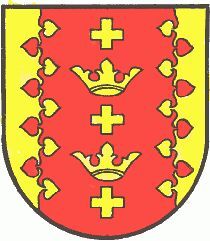Limbach bei Neudau: Difference between revisions
Knorrepoes (talk | contribs) m (Text replace - "Österreich" />" />" to "Österreich" />") |
Knorrepoes (talk | contribs) m (Text replace - "[[Literature" to "{{media}} [[Literature") |
||
| Line 19: | Line 19: | ||
patron-saint in churches at the frontiers of the Holy Roman Empire. Both saints are symbolised by a golden crown. The crosses stand for centuries of Christian life and especially the ius baptizandi, which the church | patron-saint in churches at the frontiers of the Holy Roman Empire. Both saints are symbolised by a golden crown. The crosses stand for centuries of Christian life and especially the ius baptizandi, which the church | ||
has enjoyed since the 12<sup>th</sup> century. | has enjoyed since the 12<sup>th</sup> century. | ||
{{media}} | |||
[[Literature]] : Image provided by Karl Palfrader (k.palfrader@aon.at), MStLA 47 (1997), p. 58 | [[Literature]] : Image provided by Karl Palfrader (k.palfrader@aon.at), MStLA 47 (1997), p. 58 | ||
Revision as of 00:51, 9 July 2014
| Heraldry of the World Civic heraldry of Austria - Österreichische Gemeindewappen |
LIMBACH BEI NEUDAU
State : Steiermark
District : Hartberg
Origin/meaning
The arms were granted on May 20, 1996.
The name of the municipality, Limbach, means "Lindenbach", brook of lindens. So linden-leafs were included into the arms.
Until the 18th century, there were two churches in today's Limbach, St. Oswald and St. Bartholomäus. St. Bartholomäus, Apostle and Martyr, was a favourite saint of the Emperor Otto III and was often chosen as
patron-saint in churches at the frontiers of the Holy Roman Empire. Both saints are symbolised by a golden crown. The crosses stand for centuries of Christian life and especially the ius baptizandi, which the church
has enjoyed since the 12th century.
Contact and Support
Partners:
Your logo here ?
Contact us
© since 1995, Heraldry of the World, Ralf Hartemink 
Index of the site
Literature : Image provided by Karl Palfrader (k.palfrader@aon.at), MStLA 47 (1997), p. 58











